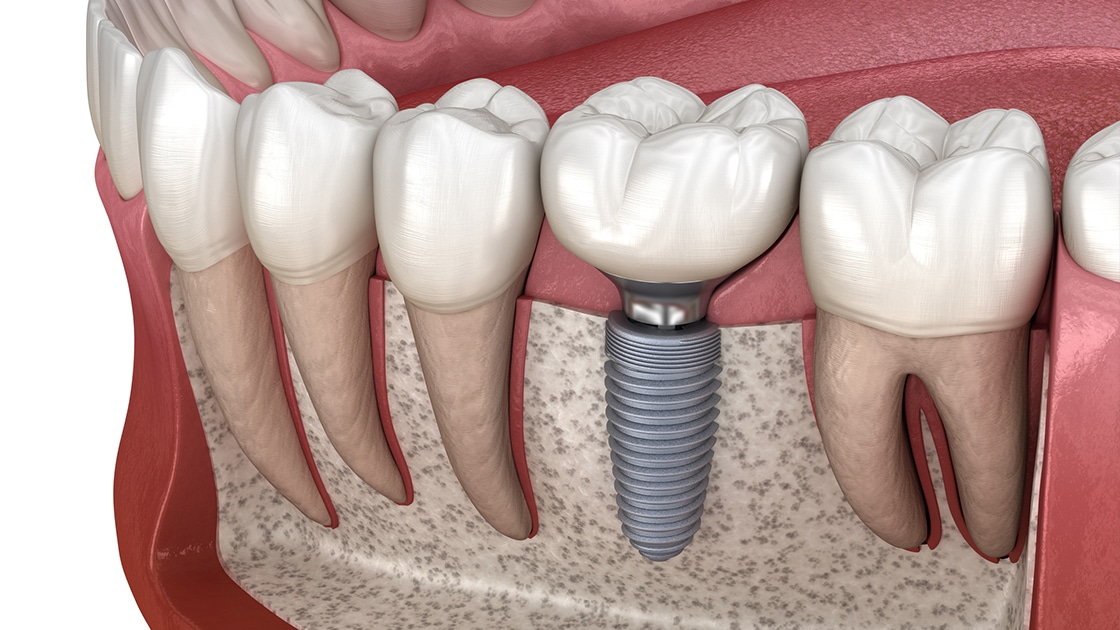All about Dental Sense
All about Dental Sense
Blog Article
Not known Facts About Dental Sense
Table of ContentsDental Sense - TruthsThe Of Dental SenseThe Single Strategy To Use For Dental SenseTop Guidelines Of Dental Sense
are medical gadgets surgically implanted right into the jaw to bring back a person's capacity to chew or their appearance. They offer support for fabricated (fake) teeth, such as crowns, bridges, or dentures. When a tooth is shed because of injury or condition, an individual can experience issues such as rapid bone loss, malfunctioning speech, or modifications to chewing patterns that lead to pain.Dental dental implant systems are composed of a dental implant body and oral implant joint and may additionally include a joint fixation screw. Dental implants. The oral implant body is surgically inserted in the jawbone in area of the tooth's root. The oral implant abutment is generally connected to the implant body by the abutment addiction screw and prolongs via gums into the mouth to sustain the attached man-made teeth
(https://padlet.com/matthewmusic33101/dental-sense-ljnep063jjnbcvdg)Framework of The Oral Implant System selecting oral implants, talk with your oral provider regarding the prospective advantages and dangers, and whether you are a candidate for the treatment. Things to consider: Your general wellness is a vital consider determining whether you are a great prospect for dental implants, how much time it will require to heal, and how much time the dental implant may stay in area.
Cigarette smoking may affect the healing procedure and reduce the long-term success of the dental implant. The recovery process for the dental implant body may take a number of months or longer, during which time you usually have a temporary joint in location of the tooth. the oral implant procedure: Thoroughly follow the oral hygiene instructions provided to you by your dental provider.
Fascination About Dental Sense
Implant failing can result in the need for an additional operation to fix or replace the dental implant system. Recovers the capacity to chew Restores cosmetic appearance Assists maintain the jawbone from reducing due to bone loss Preserves the wellness of the bordering bone and gums Assists keep nearby (neighboring) teeth steady Enhances top quality of life Damages to surrounding all-natural teeth during dental implant placement Injury to the surrounding cells throughout surgery, such as sinus perforation Injury throughout surgical procedure (for instance, crack of bordering jawbone) Poor feature, such as really feeling like the teeth do not attack with each other generally A sensation that the tooth is loose or twisting in place resulting from a joint screw loosening up Implant body failing (looseness of the dental implant body) because of systemic infection, which might be a lot more most likely in patients with unchecked diabetes mellitus as a result of neighborhood infection in bone and gum tissues supporting the dental implant body because of postponed healing, which might be most likely in individuals who smoke Trouble cleaning the gums around the dental implant, leading to bad dental hygiene Untreated periodontal condition Post-surgical numbness as a result of nerve impingement or damages Always notify healthcare service providers and imaging specialists that you have dental implants before any magnetic vibration imaging (MRI) or x-ray treatments.
FDA is not aware of any type of negative events reported for MRI or x-ray procedures with dental implants. Oral implants systems are usually made of products that adhere to worldwide agreement requirements of the International Company for Standardization (ISO) or ASTM International. These requirements have details of what makes a secure material.

An oral implant is a structure that replaces a missing tooth. With screw-like tools, the cosmetic surgeon inserts an implant right into the find here jawbone, and it functions as a support for a synthetic tooth, called a crown. A device called an abutment connects the man-made tooth to the oral implant. The crown is customized to fit the individual's mouth and match the color of their teeth.
The Best Guide To Dental Sense
Some people are not eligible for oral implant surgery. It is for dental surgeons to run on individuals with: acute illnessuncontrollable metabolic diseasebone or soft tissue illness or infectionIf these problems are resolved, an individual can have the surgery. In, dental doctors avoid operating people with: If people with any one of the above go through dental implant surgery, there is a higher risk of the dental implant falling short.

Oral dental implant surgical procedure is an individualized procedure. It's not the very same for everyone. The complying with offers a general summary of what you can anticipate your dentist, oral surgeon, periodontist or prosthodontist to do: Put the dental implant operatively. Provide you time to heal. Connect the message and last crown, bridge or denture.
Next, your cosmetic surgeon will meticulously put the dental implant into your jaw. If your dental implant is near the front of your mouth, your dental professional will make a momentary tooth for you to wear up until you recover.
Fascination About Dental Sense
Your company can inform you what to anticipate in your situation. During the recovery phase, your jawbone should fuse to the dental implant. This process, called osseointegration, is crucial for stability and long-lasting success. This procedure can take anywhere from three to 9 months. In some instances, it may take much longer.
Once your dental implant heals, your dental professional can affix the abutment (little connector post) and your final remediation (crown, bridge or denture). This generally takes about one hour to complete and may need a 2nd minor surgery. You shouldn't really feel any type of discomfort throughout your dental implant procedure since your service provider will certainly make use of medicine to numb your gum tissues.
Report this page